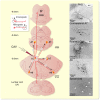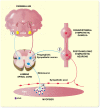Brainstem noradrenergic neurons: Identifying a hub at the intersection of cognition, motility, and skeletal muscle regulation
- PMID: 36073023
- PMCID: PMC9588743
- DOI: 10.1111/apha.13887
Brainstem noradrenergic neurons: Identifying a hub at the intersection of cognition, motility, and skeletal muscle regulation
Abstract
Brainstem noradrenergic neuron clusters form a node integrating efferents projecting to distinct areas such as those regulating cognition and skeletal muscle structure and function, and receive dissimilar afferents through established circuits to coordinate organismal responses to internal and environmental challenges. Genetic lineage tracing shows the remarkable heterogeneity of brainstem noradrenergic neurons, which may explain their varied functions. They project to the locus coeruleus, the primary source of noradrenaline in the brain, which supports learning and cognition. They also project to pre-ganglionic neurons, which lie within the spinal cord and form synapses onto post-ganglionic neurons. The synapse between descending brainstem noradrenergic neurons and pre-ganglionic spinal neurons, and these in turn with post-ganglionic noradrenergic neurons located at the paravertebral sympathetic ganglia, support an anatomical hierarchy that regulates skeletal muscle innervation, neuromuscular transmission, and muscle trophism. Whether any noradrenergic neuron subpopulation is more susceptible to damaged protein deposit and death with ageing and neurodegeneration is a relevant question that answer will help us to detect neurodegeneration at an early stage, establish prognosis, and anticipate disease progression. Loss of muscle mass and strength with ageing, termed sarcopenia, may predict impaired cognition with ageing and neurodegeneration and establish an early time to start interventions aimed at reducing central noradrenergic neurons hyperactivity. Complex multidisciplinary approaches, including genetic tracing, specific circuit labelling, optogenetics and chemogenetics, electrophysiology, and single-cell transcriptomics and proteomics, are required to test this hypothesis pre-clinical.
Keywords: ageing; cognition; motility; noradrenergic neurons; skeletal muscle.
© 2022 The Authors. Acta Physiologica published by John Wiley & Sons Ltd on behalf of Scandinavian Physiological Society.
Conflict of interest statement
The author declares that he has no conflicts of interest.
Figures






Similar articles
-
Noradrenergic modulation of cognition: therapeutic implications.J Psychopharmacol. 2013 Aug;27(8):694-718. doi: 10.1177/0269881113480988. Epub 2013 Mar 21. J Psychopharmacol. 2013. PMID: 23518815 Review.
-
Distinct brainstem to spinal cord noradrenergic pathways inversely regulate spinal neuronal activity.Brain. 2022 Jul 29;145(7):2293-2300. doi: 10.1093/brain/awac085. Brain. 2022. PMID: 35245374 Free PMC article.
-
Direct targeting of peptidergic amygdalar neurons by noradrenergic afferents: linking stress-integrative circuitry.Brain Struct Funct. 2015 Jan;220(1):541-58. doi: 10.1007/s00429-013-0674-8. Epub 2013 Nov 23. Brain Struct Funct. 2015. PMID: 24271021 Free PMC article.
-
Activation of locus coeruleus-spinal cord noradrenergic neurons alleviates neuropathic pain in mice via reducing neuroinflammation from astrocytes and microglia in spinal dorsal horn.J Neuroinflammation. 2022 May 27;19(1):123. doi: 10.1186/s12974-022-02489-9. J Neuroinflammation. 2022. PMID: 35624514 Free PMC article.
-
Neuroadaptive responses in brainstem noradrenergic nuclei following chronic morphine exposure.Mol Neurobiol. 2001 Apr-Jun;23(2-3):155-71. doi: 10.1385/mn:23:2-3:155. Mol Neurobiol. 2001. PMID: 11817217 Review.
Cited by
-
Aging disrupts locus coeruleus-driven norepinephrine transmission in the prefrontal cortex: Implications for cognitive and motor decline.Aging Cell. 2025 Jan;24(1):e14342. doi: 10.1111/acel.14342. Epub 2024 Sep 23. Aging Cell. 2025. PMID: 39312903 Free PMC article.
-
Influence of Brainstem's Area A5 on Sympathetic Outflow and Cardiorespiratory Dynamics.Biology (Basel). 2024 Mar 2;13(3):161. doi: 10.3390/biology13030161. Biology (Basel). 2024. PMID: 38534431 Free PMC article. Review.
-
Sex differences in single neuron function and proteomics profiles examined by patch-clamp and mass spectrometry in the locus coeruleus of the adult mouse.Acta Physiol (Oxf). 2024 Apr;240(4):e14123. doi: 10.1111/apha.14123. Epub 2024 Mar 8. Acta Physiol (Oxf). 2024. PMID: 38459766 Free PMC article.
-
Sympathetic circuits regulating hepatic glucose metabolism: where we stand.Physiol Rev. 2024 Jan 1;104(1):85-101. doi: 10.1152/physrev.00005.2023. Epub 2023 Jul 13. Physiol Rev. 2024. PMID: 37440208 Free PMC article. Review.
-
Early signs of neuron autonomous and non-autonomous hyperexcitability in locus coeruleus noradrenergic neurons of a mouse model of tauopathy and Alzheimer's disease.Acta Physiol (Oxf). 2025 Apr;241(4):e70022. doi: 10.1111/apha.70022. Acta Physiol (Oxf). 2025. PMID: 40083218
References
-
- Saper CB, Elmquist JK. Principles of Neural Science (eds Eric R. Kandel, J. D. Koester, S. H. Mack, & S. A. Siegelbaum). Ch. 40. Mc Graw Hill; 2021:981‐1009.
-
- Guyenet PG. The sympathetic control of blood pressure. Nat Rev Neurosci. 2006;7:335‐346. - PubMed
-
- Bennarroch EE. Autonomic Neurology. 1st ed. Oxford University Press; 2014.
-
- Saper CB, Stornetta RL. The Rat Nervous System (ed G. Paxinos). Ch. 23. Elsevier Inc; 2014:629‐673.
Publication types
MeSH terms
Substances
Grants and funding
LinkOut - more resources
Full Text Sources

